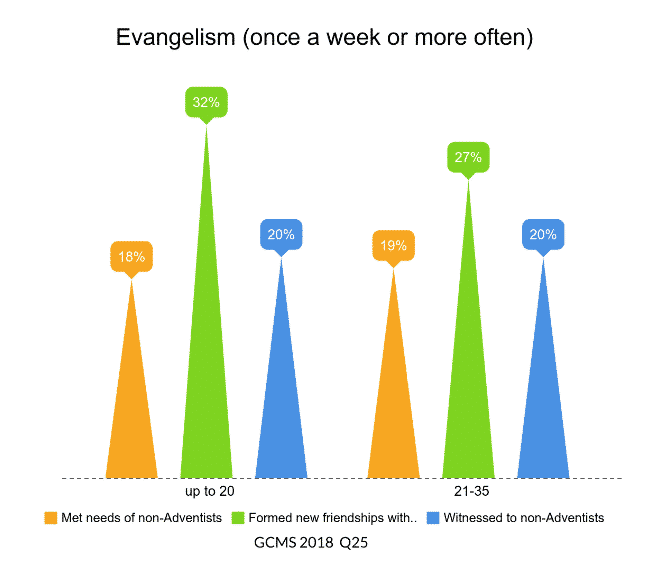Don’t let anyone look down on you because you are young, but set an example for the believers in speech, in conduct, in love, in faith and in purity. Until I come, devote yourself to the public reading of Scripture, to preaching and to teaching. Do not neglect your gift, which was given you through prophecy when the body of elders laid their hands on you. Be diligent in these matters; give yourself wholly to them, so that everyone may see your progress.
(1 Timothy 4:12-15, NIV)
To see young people involved in church life and ministries is one of the most desired goals of any Christian church. Young people bring life and hope to religious communities. Their active involvement generates enthusiasm and kindles the faith that values of the church will continue, even after the older generation has passed away from the scene of life.
The Global Church Member Survey, conducted in 2017 and 2018 in all 13 divisions with a total sample of 63,756 respondents, has a sizeable subsample of Adventist young people who comprise 25,460 participants or 40% of the sample. Some of them (28%) fall under a category of young adults of 21-35 years of age and can be called Millennials, while others (12%) are Adventists adolescents or can be called Generation Z.
What are the main characteristics of this young people sample? Both genders are well represented, with 2% more males in young adults’ subsample and 12% more females in adolescents’ subsample. Most participants (96%) consider themselves Seventh-day Adventists although just 87% of adolescents and 91% of young adults have been baptized. A small proportion of youth (8%) and about twice as many young adults (17%) are working for an Adventist organization or church. Interestingly, one third of young adults (33%) and about a quarter (26%) of adolescents are the first-generation Adventists in their families, which suggests that they were converted and need additional support from the church. While adolescents are mostly single, 47% of young adults are married and 42% have children with at least one child living at home. A very small group (3%) have children who are not living with the parents.
Having this interesting group of young Adventists participated in the global survey helped us learn more about their involvement in church life and ministry.
Sabbath is a significant feature on the weekly calendar of young Adventists. More than two-thirds of them regularly attend weekly services and Sabbath School, with an additional 19%-21% who attend them almost every week. In contrast, weekly attendance at small groups or prayer meetings is not high. Interestingly, slightly more adolescents attend weekly prayer meetings than young adults: this might be explained by their being free from some responsibilities in the evenings as singles, or might mean they are accompanying their parents! Only about a third of adolescents attend weekly pathfinder or youth meetings in their areas.


Although 41% of young people 21-35 years old and 37% of respondents up to 20 indicated they hold an office at their local church, apparently, this does not require their involvement on a weekly basis as the figures below show. Only slightly more than a third of young adults said that they were involved in a church ministry on Sabbath during the last 12 months, and the number of adolescents was even less—only 28%. The percentage of those who helped with a church ministry during the week was notably lower again. This means that only about half of regular churchgoers from the young adult group are involved in church ministry on Sabbath, while a majority of adolescents who attend church weekly are not involved in any ministry in the church. Apparently, the business of everyday life prevents the majority of both groups to be involved in a church ministry during the week either.

What about involvement in ministry to those people who are not part of the Seventh-day Adventist church? Although about 70% of young Adventists responding to the survey claimed that they are actively involved in carrying out the mission of their local church, in practice, not many of them were involved in actual activities during the last 12 months. As the graph below shows, both groups were more active in forming new friendships with non-Adventists than meeting needs of people in the community or witnessing to them.

However, there is a positive trend. A strong majority of Adventist young people—over 70% of young adults and over 60% of adolescents acknowledge that ministry and service—whether involvement in evangelistic outreach through their local church, or meeting the needs of their local communities, or caring, nurturing, and reclaiming former members—should increase. The highest response from both groups was regarding their personal involvement in reclaiming of former members—about 35% of adolescents and 41% of young adults said it should increase greatly. This suggests that they have friends who stopped attending the church and want to bring them back.


Obviously, young people’s lives are extremely busy today. They are pursuing education, dealing with careers, and chasing their dreams. They are handling friendships and family relationships, with some taking care of their children. All are trying to make the most of their lives. With such busy lifestyles, young people hardly have any free time left for the service. However, does the Church need them? Can the Church survive without them? We have big numbers of young Adventists attending our churches every week who are willing to increase their involvement in church life and ministry. Will the Church take this chance and help them become its leaders of tomorrow? Only through practicing their gifts, they can make progress as the apostle Paul said. Only then, with young people involved, the Church will have the future.
For more information on the 2018 GCMS data regarding young Adventists click here.
blog written by Galina Stele

